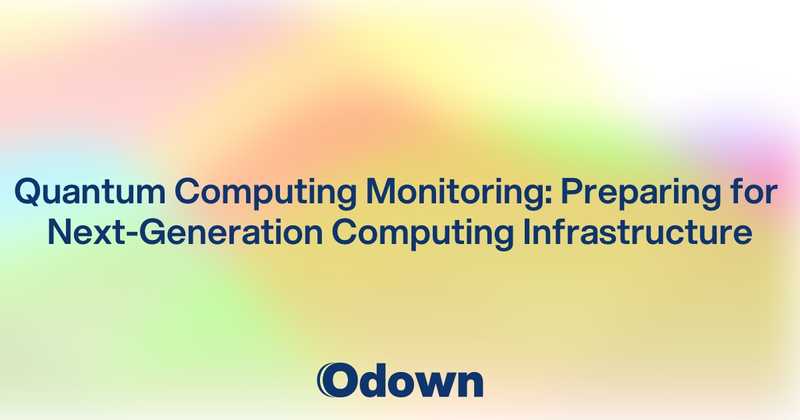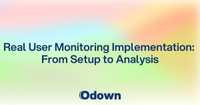Quantum Computing Monitoring: Preparing for Next-Generation Computing Infrastructure
Your quantum processor just lost coherence during a critical optimization calculation, corrupting hours of computational work. Your hybrid classical-quantum system is experiencing intermittent communication failures between quantum and classical components. Your quantum cryptography implementation shows unusual error patterns that might indicate security vulnerabilities. These aren't theoretical problems---they're the monitoring challenges that early quantum computing adopters face today.
Quantum computing represents the most significant shift in computational paradigms since the invention of the transistor. While large-scale quantum computers remain experimental, organizations are already building hybrid systems that combine classical and quantum processing for specific use cases.
Monitoring quantum systems requires understanding entirely new concepts like quantum coherence, error rates, and decoherence times. Traditional monitoring approaches that work for classical computers fail completely when applied to quantum hardware that operates according to quantum mechanical principles.
Forward-thinking monitoring platforms are beginning to incorporate quantum-ready monitoring capabilities as organizations prepare for the quantum computing era. But effective quantum monitoring requires understanding quantum mechanics, specialized hardware constraints, and the unique challenges of managing quantum-classical hybrid systems.
Quantum Computing Fundamentals: Qubits, Coherence, and Error Rates
Quantum computers operate according to quantum mechanical principles that create monitoring requirements unlike anything in classical computing.
Qubit State and Coherence Monitoring
Qubits are the fundamental units of quantum computation and require specialized monitoring approaches:
Coherence time monitoring tracks how long qubits maintain their quantum states before decoherence destroys quantum information. Coherence times vary between different qubit technologies and degrade over time due to environmental factors.
Qubit fidelity measurement determines how accurately quantum operations preserve intended qubit states. High fidelity is essential for quantum algorithms to produce correct results, and fidelity degradation indicates hardware problems.
Entanglement quality monitoring tracks the strength and persistence of quantum entanglement between qubits. Entanglement is crucial for quantum computing advantage, and monitoring helps optimize quantum gate operations.
Quantum Error Rate Analysis
Quantum systems are inherently noisy and require sophisticated error monitoring:
Single-qubit error rates measure how often individual qubits experience state flips or other errors. These errors accumulate during quantum computations and affect overall algorithm success rates.
Two-qubit gate error rates track errors that occur during quantum gate operations between qubits. Gate errors are typically higher than single-qubit errors and often limit quantum algorithm performance.
Correlated error detection identifies patterns where errors in one qubit affect neighboring qubits. Correlated errors can cascade through quantum circuits and cause catastrophic computation failures.
Environmental Stability Monitoring
Quantum systems are extremely sensitive to environmental conditions that must be carefully monitored:
Temperature stability monitoring tracks the ultra-low temperatures required for many quantum systems. Temperature fluctuations of millikelvins can destroy quantum coherence and affect system performance.
Electromagnetic interference monitoring detects external electromagnetic fields that can cause qubit decoherence. Even small electromagnetic disturbances can significantly impact quantum computation quality.
Vibration and mechanical stability monitoring ensures that quantum hardware remains isolated from physical disturbances. Mechanical vibrations can couple to quantum systems and introduce errors.
Quantum System Monitoring: Hardware Stability and Performance Metrics
Quantum computing hardware has unique characteristics that require specialized monitoring approaches different from classical computing systems.
Quantum Processor Performance
Quantum processors have performance metrics that don't exist in classical computing:
Quantum volume measurement provides a comprehensive metric for quantum computer capability that accounts for both qubit count and error rates. Quantum volume helps compare different quantum systems and track improvement over time.
Circuit depth capability monitoring tracks how many quantum operations can be performed before errors accumulate to unacceptable levels. Greater circuit depth enables more complex quantum algorithms.
Quantum advantage benchmarking compares quantum algorithm performance against classical implementations to verify when quantum systems provide computational advantages. This benchmarking helps justify quantum computing investments.
Cryogenic System Monitoring
Many quantum computers require sophisticated cryogenic systems that need careful monitoring:
Dilution refrigerator performance tracks the cooling systems that maintain millikelvin temperatures required for quantum coherence. Cooling system failures can destroy quantum states and damage expensive hardware.
Thermal isolation monitoring ensures that heat from classical electronics doesn't reach quantum processors. Thermal leaks can cause decoherence and reduce quantum system performance.
Cryogenic component health monitoring tracks pumps, heat exchangers, and other critical cooling system components. Preventive maintenance based on monitoring data prevents costly quantum system downtime.
Control System Integration
Quantum computers require sophisticated control systems that interface between classical and quantum domains:
Control pulse fidelity monitoring ensures that classical control systems accurately implement intended quantum operations. Control errors can masquerade as quantum errors and affect algorithm performance.
Timing precision monitoring tracks nanosecond-level timing accuracy required for quantum operations. Timing jitter can cause quantum gate errors and reduce overall system performance.
Calibration drift monitoring detects when quantum system parameters change over time and require recalibration. Regular calibration is essential for maintaining quantum system performance.
Hybrid Classical-Quantum Monitoring: Integration and Performance Correlation
Most practical quantum computing applications use hybrid systems that combine classical and quantum processing, requiring monitoring approaches that span both domains.
Classical-Quantum Interface Monitoring
The interface between classical and quantum systems creates unique monitoring challenges:
Data transfer latency monitoring tracks delays in moving data between classical and quantum processors. High latency can limit the effectiveness of hybrid algorithms that require rapid classical-quantum communication.
Error propagation analysis identifies how errors in classical systems affect quantum computations and vice versa. Error propagation can amplify problems and make troubleshooting more difficult.
Synchronization monitoring ensures that classical and quantum components remain coordinated during hybrid algorithm execution. Synchronization failures can cause algorithm errors that are difficult to diagnose.
Workload Distribution and Optimization
Hybrid systems must effectively distribute work between classical and quantum components:
Algorithm partitioning monitoring tracks how effectively hybrid algorithms divide work between classical and quantum processors. Optimal partitioning maximizes quantum advantage while minimizing overall computation time.
Resource utilization correlation analyzes how classical resource usage affects quantum system performance and efficiency. Classical processing bottlenecks can limit overall hybrid system performance.
Cost-benefit analysis monitoring tracks whether quantum processing provides sufficient advantage to justify its higher cost compared to classical alternatives. This analysis helps optimize quantum resource allocation.
Performance Correlation Analysis
Understanding relationships between classical and quantum performance helps optimize hybrid systems:
Classical preprocessing optimization monitors how classical data preparation affects quantum algorithm performance. Better classical preprocessing can reduce quantum resource requirements.
Quantum result validation tracking ensures that quantum computations produce reliable results that classical systems can use effectively. Quantum errors can propagate through classical post-processing stages.
End-to-end performance monitoring tracks complete hybrid algorithm execution from classical input through quantum processing to classical output. This monitoring helps identify optimization opportunities across the entire workflow.
Quantum Computing Security Monitoring: Quantum-Safe Cryptography and Protection
Quantum computing creates both security opportunities and threats that require new monitoring approaches for cryptographic systems and data protection.
Quantum-Safe Cryptography Monitoring
Organizations must prepare for the eventual threat that quantum computers pose to current cryptographic systems:
Cryptographic agility assessment monitors how quickly organizations can transition from quantum-vulnerable to quantum-safe cryptographic algorithms. Rapid transition capability is essential for maintaining security.
Post-quantum algorithm performance monitoring tracks the computational overhead of quantum-safe cryptographic methods. Performance impact affects user experience and system scalability.
Quantum threat timeline monitoring tracks advances in quantum computing that might affect cryptographic security timelines. Early warning helps organizations prepare for cryptographic transitions.
Quantum Key Distribution Monitoring
Quantum key distribution provides theoretically unbreakable communication security but requires specialized monitoring:
Quantum channel integrity monitoring detects eavesdropping attempts on quantum communication channels. Quantum mechanics guarantees that eavesdropping introduces detectable disturbances.
Key generation rate monitoring tracks how quickly quantum systems can generate secure cryptographic keys. Key generation rates affect communication system scalability and performance.
Error rate analysis in quantum communication helps distinguish between environmental noise and potential security attacks. Unusual error patterns might indicate adversarial interference.
Quantum Computing Attack Detection
Organizations must monitor for attacks that use quantum computing capabilities:
Cryptographic vulnerability scanning identifies systems that use quantum-vulnerable encryption algorithms. These systems need priority attention for quantum-safe upgrades.
Quantum algorithm threat assessment monitors research advances that might create new attack vectors using quantum computing. Threat intelligence helps prioritize security investments.
Quantum simulation attack detection identifies attempts to use quantum simulators to break classical cryptographic systems. Early quantum systems might threaten specific cryptographic implementations before achieving general quantum advantage.
Quantum computing monitoring builds on traditional monitoring foundations while addressing entirely new technological paradigms. Blockchain monitoring strategies provide relevant experience for monitoring complex distributed systems with consensus requirements.
Ready to prepare your monitoring infrastructure for the quantum computing era? Use Odown and build monitoring capabilities that can evolve with next-generation computing technologies while maintaining visibility and control across classical and quantum systems.



